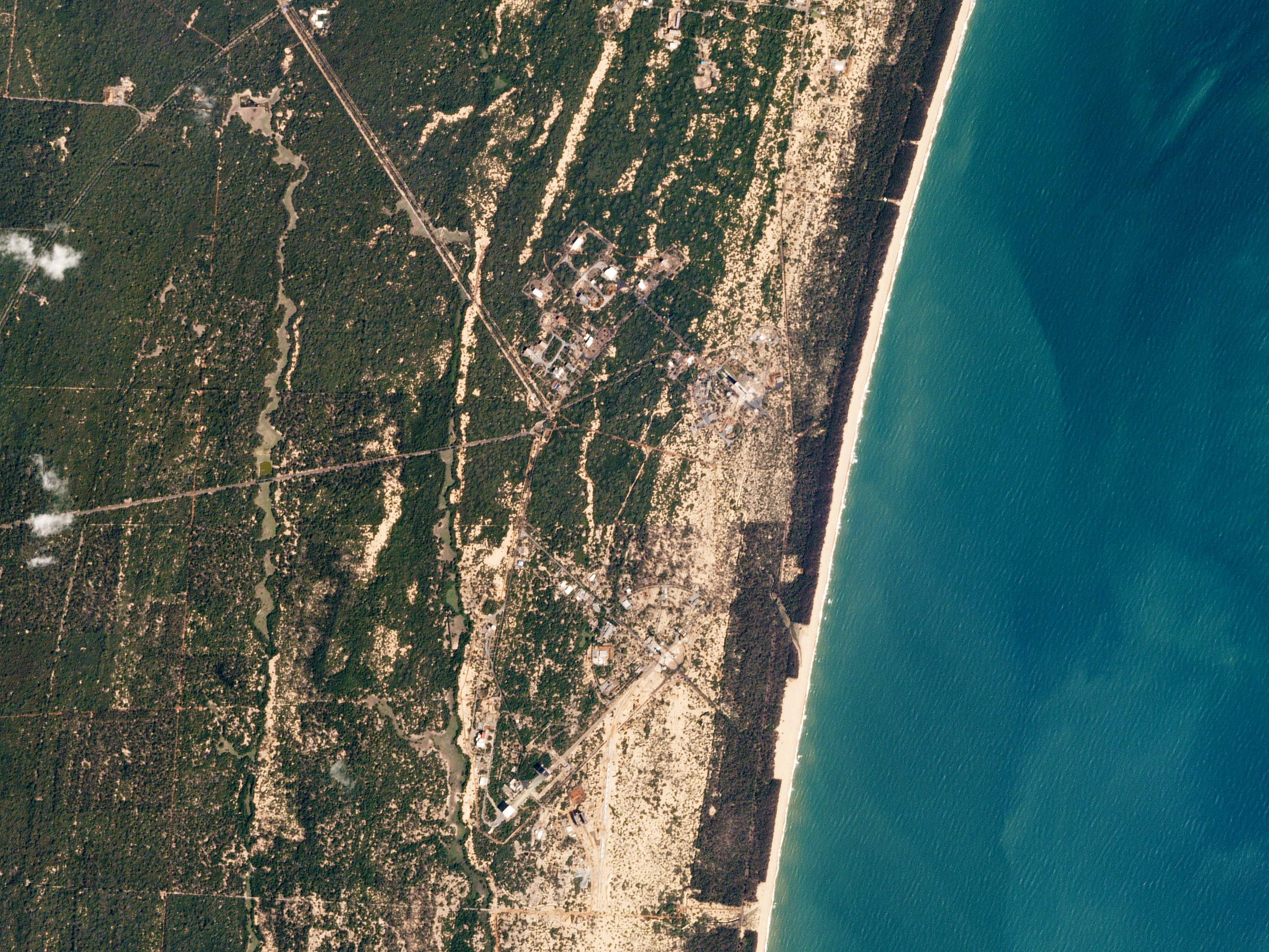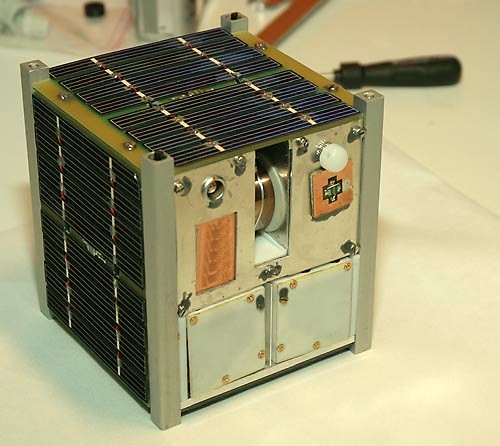|
Al Farabi-1
Al-Farabi 1 is a nano-satellite that was successfully launched on February 15, 2017, 3:58 UTC on PSLV-C37 on a record-breaking launch which released 104 satellites. It is a research satellite designed and built by Al-Farabi Kazakh National University, Almaty, Kazakhstan. The main goal of the project was to solve educational and technological tasks. Cubesat had a 2U form factor. The satellite was equipped with a number of experimental systems and remote sensing nano-camera. SPUTNIX team have developed one of the communication and data transmission systems, as well as antennas, for this satellite. Specifications Al-Farabi 1 is a 2U CubeSat A CubeSat is a class of miniaturized satellite based around a form factor consisting of cubes. CubeSats have a mass of no more than per unit, and often use commercial off-the-shelf (COTS) components for their electronics and structure. CubeSat ..., weighing 1.7 kg. References Satellites of Kazakhstan Spacecraft launched in 2017 ... [...More Info...] [...Related Items...] OR: [Wikipedia] [Google] [Baidu] |
PSLV-C37
PSLV-C37 was the 39th mission of the Indian Polar Satellite Launch Vehicle (PSLV) program and its 16th mission in the XL configuration. PSLV-C37 successfully carried and deployed a record 104 satellites in sun-synchronous orbits. Launched on 15 February 2017 by the Indian Space Research Organisation (ISRO) from the Satish Dhawan Space Centre at Sriharikota, Andhra Pradesh. According to ISRO, the 101 international satellites were launched as part of a commercial arrangement between several firms and its commercial arm Antrix Corporation Limited, run under the auspices of the Indian Government's Department of Space. Launch PSLV-C37 was launched from the First Launch Pad of Satish Dhawan Space Centre in Sriharikota at 09:28 IST on 15 February 2017. It was the 39th flight of the PSLV and the sixteenth in the XL configuration. It carried a total of 104 satellites including the primary payload Cartosat-2D. The launcher started placing the satellites into polar Sun-synchronous or ... [...More Info...] [...Related Items...] OR: [Wikipedia] [Google] [Baidu] |
Al-Farabi Kazakh National University
Al-Farabi Kazakh National University ( kz, Әл-Фараби атындағы Қазақ ұлттық университеті, Äl-Farabi atyndağy Qazaq Ūlttyq Universitetı), also called KazGU or KazNU, is a university in Almaty, Kazakhstan. Named after the Eastern philosopher and scholar al-Farabi, it is one of the country's largest universities. KazNU is the oldest classical university of the Republic established by a Decree of the Kazakh Regional Committee (KRC) office dated November 13, 1933. One year after Kazakhstan's 1990 declaration of independence, the name was changed to Al-Farabi Kazakh State University. According to the QS World University Rankings 2021 KazNU takes 165th place in the rating of the best universities of the world. In 2001, the government classified it as a "national" university. More than 20,000 students, post-graduates and PhD students study at KazNU, and there are more than 2500 faculty members working at KazNU, including 400 doctors of science ... [...More Info...] [...Related Items...] OR: [Wikipedia] [Google] [Baidu] |
Almaty
Almaty (; kk, Алматы; ), formerly known as Alma-Ata ( kk, Алма-Ата), is the largest city in Kazakhstan, with a population of about 2 million. It was the capital of Kazakhstan from 1929 to 1936 as an autonomous republic as part of the Soviet Union, then from 1936 to 1991 as a union republic and finally from 1991 as an independent state to 1997 when the government relocated the capital to Akmola (renamed Astana in 1998, Nur-Sultan in 2019, and back to Astana in 2022). Almaty is still the major commercial, financial, and cultural centre of Kazakhstan, as well as its most populous and most cosmopolitan city. The city is located in the mountainous area of southern Kazakhstan near the border with Kyrgyzstan in the foothills of the Trans-Ili Alatau at an elevation of 700–900 m (2,300–3,000 feet), where the Large and Small Almatinka rivers run into the plain. [...More Info...] [...Related Items...] OR: [Wikipedia] [Google] [Baidu] |
Kazakhstan
Kazakhstan, officially the Republic of Kazakhstan, is a transcontinental country located mainly in Central Asia and partly in Eastern Europe. It borders Russia Russia (, , ), or the Russian Federation, is a transcontinental country spanning Eastern Europe and Northern Asia. It is the largest country in the world, with its internationally recognised territory covering , and encompassing one-eigh ... to Kazakhstan–Russia border, the north and west, China to China–Kazakhstan border, the east, Kyrgyzstan to Kazakhstan–Kyrgyzstan border, the southeast, Uzbekistan to Kazakhstan–Uzbekistan border, the south, and Turkmenistan to Kazakhstan–Turkmenistan border, the southwest, with a coastline along the Caspian Sea. Its capital is Astana, known as Nur-Sultan from 2019 to 2022. Almaty, Kazakhstan's largest city, was the country's capital until 1997. Kazakhstan is the world's largest landlocked country, the largest and northernmost Muslim world, Muslim-majority cou ... [...More Info...] [...Related Items...] OR: [Wikipedia] [Google] [Baidu] |
Remote Sensing
Remote sensing is the acquisition of information about an object or phenomenon without making physical contact with the object, in contrast to in situ or on-site observation. The term is applied especially to acquiring information about Earth and other planets. Remote sensing is used in numerous fields, including geography, land surveying and most Earth science disciplines (e.g. hydrology, ecology, meteorology, oceanography, glaciology, geology); it also has military, intelligence, commercial, economic, planning, and humanitarian applications, among others. In current usage, the term ''remote sensing'' generally refers to the use of satellite- or aircraft-based sensor technologies to detect and classify objects on Earth. It includes the surface and the atmosphere and oceans, based on propagated signals (e.g. electromagnetic radiation). It may be split into "active" remote sensing (when a signal is emitted by a satellite or aircraft to the object and its reflection dete ... [...More Info...] [...Related Items...] OR: [Wikipedia] [Google] [Baidu] |
CubeSat
A CubeSat is a class of miniaturized satellite based around a form factor consisting of cubes. CubeSats have a mass of no more than per unit, and often use commercial off-the-shelf (COTS) components for their electronics and structure. CubeSats are put into orbit by deployers on the International Space Station, or launched as secondary payloads on a launch vehicle. , more than 1,600 CubeSats have been launched. In 1999, California Polytechnic State University (Cal Poly) professor Jordi Puig-Suari and Bob Twiggs, a professor at Stanford University Space Systems Development Laboratory, developed the CubeSat specifications to promote and develop the skills necessary for the design, manufacture, and testing of small satellites intended for low Earth orbit (LEO) that perform a number of scientific research functions and explore new space technologies. Academia accounted for the majority of CubeSat launches until 2013, when more than half of launches were for non-academic purpose ... [...More Info...] [...Related Items...] OR: [Wikipedia] [Google] [Baidu] |
Satellites Of Kazakhstan
A satellite or artificial satellite is an object intentionally placed into orbit in outer space. Except for passive satellites, most satellites have an electricity generation system for equipment on board, such as solar panels or radioisotope thermoelectric generators (RTGs). Most satellites also have a method of communication to ground stations, called Transponder (satellite communications), transponders. Many satellites use a Satellite bus, standardized bus to save cost and work, the most popular of which is small CubeSats. Similar satellites can work together as a group, forming Satellite constellation, constellations. Because of the high launch cost to space, satellites are designed to be as lightweight and robust as possible. Most communication satellites are radio Broadcast relay station, relay stations in orbit and carry dozens of transponders, each with a bandwidth of tens of megahertz. Satellites are placed from the surface to orbit by launch vehicles, high enough to ... [...More Info...] [...Related Items...] OR: [Wikipedia] [Google] [Baidu] |
Spacecraft Launched In 2017
A spacecraft is a vehicle or machine designed to fly in outer space. A type of artificial satellite, spacecraft are used for a variety of purposes, including communications, Earth observation, meteorology, navigation, space colonization, planetary exploration, and transportation of humans and cargo. All spacecraft except single-stage-to-orbit vehicles cannot get into space on their own, and require a launch vehicle (carrier rocket). On a sub-orbital spaceflight, a space vehicle enters space and then returns to the surface without having gained sufficient energy or velocity to make a full Earth orbit. For orbital spaceflights, spacecraft enter closed orbits around the Earth or around other celestial bodies. Spacecraft used for human spaceflight carry people on board as crew or passengers from start or on orbit (space stations) only, whereas those used for robotic space missions operate either autonomously or telerobotically. Robotic spacecraft used to support scientifi ... [...More Info...] [...Related Items...] OR: [Wikipedia] [Google] [Baidu] |






